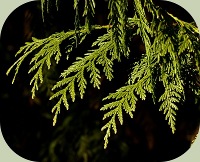Herbal Cold Remedy
Using Wild Plants to Heal a Cold

Include an herbal cold remedy in your house because t'is the season for coughing, sneezing and overall unpleasantness that accompanies seasonal colds. While there is no "cure" for the common cold, there are wild herbs that assist the immune system in warding off nasty bugs and soothing your symptoms. It's helpful to have an herbal cold remedy in your medicine cabinet when you feel that first irritation in your throat that hints the onset of a cold.
Herbal Cold Remedy Fundamentals
Cedar leaves (also known as fronds), combined with roots or inner bark of the Oregon grape, make a powerful herbal cold remedy. I make a tincture of western red cedar (Thuja plicata) and Oregon grape (Mahonia nervosa) for a number of friends and family who find that it helps tremendously.
The western red cedar is a large conifer tree in our local pacific northwest forests which grows in lower elevations and moist conditions. The low Oregon grape is an evergreen shrub that grows in our local forest understory. Tall Oregon grape grows in sunnier, often drier conditions and is more common in eastern Washington. Both work as medicine.
The best time to harvest the leaf-like fronds of western red cedar is in the summer or fall. Cedar is an immuno-stimulant. Small, daily doses enhance resistance to respiratory and intestinal infections. Cedar leaf tea is also helpful for relieving mucus-heavy bronchial tubes. Steep cedar leaves for no more than 20 minutes since they contain volatile oils. These volatile oils are not released through tincturing or briefly-steeped teas.
Oregon grape (Mahonia nervosa, aquifolium, repens and pinnata) contains berberine, the medicinal substance within the cambium layer of the plant. Taken internally, Oregon grape is a bitter which aids digestion, is antimicrobial for the intestinal track, and is a liver stimulant which helps clean the body. The best time to harvest Oregon grape is the late fall and winter when the energy of the plant is in the root, rather than spring when the plant's energy goes to the leaves. Harvest the root and the lower stem.
Learn about and practice safe and ethical harvesting. Don't take more than 1 in 20 plants and don't take from small or sensitive populations. Never harvest medicine near roads or other contaminated sites.
Be More Prepared For Your Next Outdoor Adventure!

Don't leave home without knowing these six essential survival skills. Our free survival mini guide reveals the strategies of:
- Shelter & fire to prevent the number one cause of death
- Obtaining clean water to avoid life-threatening dehydration
- Common wild survival foods and other critical skills!

To create the herbal cold remedy tincture, use equal parts of small cut pieces (1 inch lengths) of western red cedar leaves and shavings from the cleaned root and inner bark of the Oregon grape. Remove the outer bark of the Oregon grape stem and root carefully with a knife and shave up the inner bark. You will see the bright yellow berberine in the inner bark. This is the medicinal part you want to keep. Fill a mason jar 3/4 full and cover and soak the plant material in alcohol (grain alcohol or vodka work well) or vinegar. Soak for at least 14 days, shaking it now and then. Many believe that tinctures are most powerful by timing the soak with the lunar cycle. To do so, start your tincture on the new moon and end with the full moon. Store it in a cool, dark, dry place.
Strain the herb and capture the liquid and store it in an amber tincture bottle. Label it with the herbs, menstrum (alcohol or vinegar) and date. Dosage for adults is an eye dropper full three times per day for no more than seven days in a row. See other tincture recipes.
Neither Oregon grape nor cedar is recommended for pregnant or nursing mothers and cedar should not be used by people with kidney conditions. When learning any herb, start simple. Don't combine numerous herbs at the same time. Really get to know what you are using one or two at a time.
Heal well!
By the way, when you're out foraging, it's important to know how to stay safe in the outdoors, especially if you were to get lost. Right now you can get a free copy of our mini survival guide here, where you'll discover six key strategies for outdoor emergencies, plus often-overlooked survival tips.
Further Resources:
Plants of the Pacific West by Michael Moore
Discovering Wild Plants by Janice J. Schofield
Wild Edible and Medicinal Plants Courses at Alderleaf

About the Author: Heather Swift is an experienced naturalist, teacher, and ethnobotanist. She teaches about plants at Alderleaf. Learn more about Heather Swift.
Return from Herbal Cold Remedy back to Wild Plants Articles
Is The Essential Wilderness Survival Skills Course Right for You? Take the "Online Survival Training Readiness" Quiz
See for yourself if this eye-opening course is a good fit for you. It takes just a few minutes! Get your Survival Training Readiness Score Now!

Grow Your Outdoor Skills! Get monthly updates on new wilderness skills, upcoming courses, and special opportunities. Join the free Alderleaf eNews and as a welcome gift you'll get a copy of our Mini Survival Guide.

 The Six Keys to Survival: Get a free copy of our survival mini-guide and monthly tips!
The Six Keys to Survival: Get a free copy of our survival mini-guide and monthly tips!
Learn more